New Stuff[hide]
Reportes: From The St... : Cubadisco 2...
Tienda: Cuban Music Store
Reportes: From The St... : Cubadisco 2...
Fotos: Tom Ehrlich
Staff: Kristina Lim
Musicos: Juan Formell
Musicos: Yordamis Megret Planes
Musicos: Yasser Morejón Pino
Musicos: José Luis "Changuito" Quintana...
Musicos: Dennis Nicles Cobas
Fotos: Eli Silva
Grupos: Ritmo Oriental : 1988 - Vol. IX - 30 a...
Musicos: Rafael Paseiro Monzón
Musicos: Jiovanni Cofiño Sánchez
Photos of the Day [hide]
Concert Report & Interview - Berlin - 2002
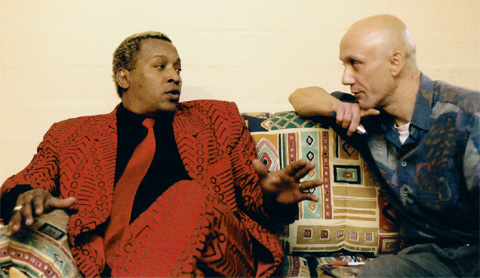
El Barrio in Berlin (Germany) / November 24th, 2002
by Maarten Hendrik Liefrink
all photos by Julia Peschel
Click for Julia's website
As I left the room backstage in El Barrio in Berlin (Germany) at 2:00 am, I could not believe I had been there! It happened right there! Tosco and myself sitting on this couch having this long, long conversation. I must have been struck by the very reality he just wanted to sit there with me answering any question I would ask him and to talk about whatever he wanted to talk about.
The manager of the club is a really nice person who actually put us together. He had simply asked him if he did not care about an interview. We met and spoke with each other before the concert started.
As the concert should start in about 10 minutes there was not too much time. Tosco was not that relaxed at that moment having the concert ahead, not even knowing (about) me.
I was afraid the interview could be one of those many he had had before having to answer questions ...
Would he be bored soon?
He told me that the concert had not been announced correctly. (Some members of) NG La Banda were on holiday. Therefore this would be a concert of José Luis Cortés y sus Estrellas.
Only Miguel de Armas, Pablo Cortés, Feliciano Arango, Jorge Baglan and Mónica Mesa were there from NG La Banda. The others had been invited. He told me they had been practising this nights program the same afternoon, as he would be on a Jazz tour actually.
As we were just talking about "Crónica Social", there was not too much time left. I was really surprised he asked me to continue our conversation after the concert so we would have plenty of time. He would explain more about "Crónica Social".
At that time I could not even think of what was to come in the second part. After the concert he would probably be tired, annoyed, etc.
NOPE !
As he was tired and soaking wet after the performance, nobody could drag him to some after-show party. After he had been served another of many whiskies and had smoked another of many, many cigarettes to come he was prepared.
As we talked for almost one and a half hour, my photographer was taking dozens of pictures. This did not seem to bother him at all. In fact, José Luis seemed to enjoy the whole thing whilst having a long nice conversation about Cuba, timba etc. Here are Tosco's thoughts on a variety of subjects:
Timba music, the future of Timba,
the Buena Vista Social Club and mainstream
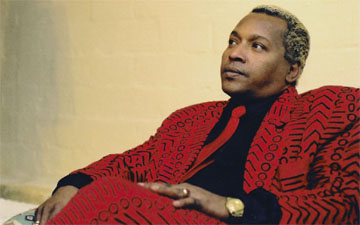
"Buena Vista Social Club makes fine Cuban music. Being a Cuban I am happy they perform everywhere promoting Cuba and its music around the world. It is great they have success and earn a living with it.
Their music is what Cuban traditional music was like about 40-50 years ago performed by Beny Moré, Arsenio Rodríguez, etc., etc.
The revival of Buena Vista Social Club by Ry Cooder is not quite fair, as they were neither musicians of any importance at all, nor were they famous performing the music of those days that long ago.
The revival of this particular traditional Cuban music ignores the existence of modern and post-modern Cuban music now and how Cuban music has been creatively innovated and developed in the last 40-50 years. I state that Ry Cooder did a very bad job.
There are several reasons why timba is not as popular or known as Buena Vista Social Club or any other salsa music that exists today.
People got used to easier-listening / -danceable salsa music that is made to boom by e.g. Oscar d'Leon, Grupo Niche, Roberto Roena, Ruben Blades, etc., etc.
Timba is most dificult to understand and to listen or dance to. It takes time to get used to its sound and rhythm.
Timba was not heard that easy outside Cuba some time, as timberos only performed on the island where they were and still are very popular. Now that timberos can easier perform outside Cuba and some of them left abroad, timba can be heard more and easier abroad.
They will have to make up with other salsa music, that spread and boomed years ago.
At the same time, the music of Buena Vista Social Club is what people know and think of as the only Cuban music ever."
His masterpiece album "La Bruja"
"La Bruja", the song
"This song is about a girlfriend I had. She worked as a professional bailarina in a show / club. She told me she loved me truly. One day she met this Puertorican guy. I assume he liked / loved her as he bought her gifts and in the end wanted to be together with her / marry her. Being offered a better life abroad with this guy, whom she did not love, she left me. She kept telling me, she would only love me, but wanted a better life I could not offer / give her.
A woman not having any true feelings, being rather sly or cunning is the "bruja sin sentimiento" meant in this song because "el precio del espíritu no se subasta".
(I would translate "bruja": Bitch, witch, etc. / "el precio del espíritu … : You can not buy love or happiness in life, sell your soul or feelings)."
"Picadillo de soya", the song
"As communism was disappearing bit by bit, the Berlin Wall had been opened, etc., Cuba ended up standing on his own with little or hardly any trade relations. The "special period" was declared by the government to handle the economical "crisis".
An example of the government's policy was to introduce soy food. Only children and elder people "could get" meat. This soy stuff was a mince-like mix made of "meat remainders" like entrails, oxtail and of course soy. I do not like it, it is disgusting.
I think of Yemayá (an orisha, she rules / reigns the oceans and the seas) telling us Cubans not to worry about food. Living on an island in her empire, we will be feeded always. She provides us whatever we need. That is why I do not understand / agree the government's policy making us to eat this stuff ¡(co)ño!-. We should not and would not have to eat it.
There is much irony in "picadillo de soya". We sing about the most "terrible thing" that could happen to us. Tony tells you what a great cook he is, but he does not know how to prepare soy. We sing about the importance of keeping the lit on the pan, otherwise the smell would escape.
I do a rap on how great, wholesome and nutritious soy is. People would love soy all over the world, as it is eaten in many countries I list. Women look gorgeous as they eat this stuff. I list all the vitamins that soy would contain. It would have so many that I run through almost the entire alphabet arriving at Ñ(o). That is is short for coño. In this case it means bull shit.
No doubt the government did not like lyrics of the song. They did not want it to be sung. As the song was against the government's policy, I was suspended from radio and television."
What is "Crónica Social" about?
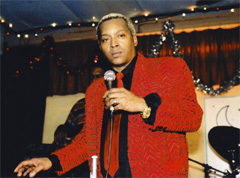
As Kevin Moore (from Timba.com) pointed out in his massive review on NG La Banda, this is a long lost NG song. It was probably the hardest NG song to find. It was censored by the Cuban governement and never recorded. He has finally tracked down a live performance from La Piragua in 1996 and put the song on www.timba.com.
This was only a few days before I would meet Tosco ! A few days and nights I hardly slept listening to this song a hundred times, over and over again …
Finally I managed to write down the complete lyrics. A Cuban friend of mine helped me out with the missing parts. I had a clue what the song was more or less about. At least I was prepared to ask Tosco more about it.
As we talked about this song and he went into many details, this part is a reproduction in my own words of all we talked about concerning this song.
This is not just "a beautiful song". It is a dramatic expression of the lower class black people feeling not accepted (for their music) and discriminated. It is both wonderful and marvelously rapped by Tosco and sung by Tony Calá. This "Cuban Soul Music" raises both protest and accusation.
The question with "Crónica Social" is whom this song is for or whom the lyrics aim at. Whom is Tosco "talking" to? Why was it censored?
"Crónica Social" is like the narration of a record on contemporary history and daily events of Cuba for the Cuban establishment.
There is a marvelous introductory start of the song where he tells us about himself.
After he had suffered "on his way" from Santa Clara to La Habana having to do awful jobs, sleeping at night in the open, etc., it was through faith, Changó, his believe in progression, efforts to survive in life, etc. it all "came on his feet".
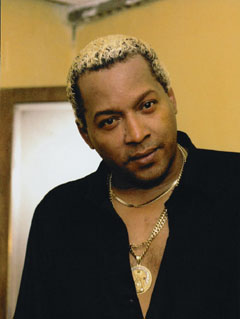 He had the oportunity to study Mozart, Beethoven, Haydn, Strawinski, Mussorksi, literature, etc. He knew where he came from and what real life is all about: Life in the "barrio" is like / about … te matan por un centavo, te salvan por un millón. The importance of Cuban popular music had always been there.
He had the oportunity to study Mozart, Beethoven, Haydn, Strawinski, Mussorksi, literature, etc. He knew where he came from and what real life is all about: Life in the "barrio" is like / about … te matan por un centavo, te salvan por un millón. The importance of Cuban popular music had always been there.
He asks if they have seen / been to ... los solares de Cuba ... Los Hoyos de Santiago. He asks if they know how life is for those who live there. People who start there daily live a las cinco de la mañunga (mañana): Poor and humble people, blacks.
He is convinced they do not know at all what life is about right there in those places as they probably will not have been there ever: ... mentira, y esto te lo digo porque es la verdad ...
Tremendos Cubanos living in those places create(d) fine and highly qualified music. In the song he reproaches those critics with their ignorance and rejection of (modern) popular Cuban music. This music has its origins deeply rooted in those places mentioned above where real and honoust Cubanía and Cubanidad can be found. There is this betrayal of real Cubanía and Cubanidad, that he can not stand anymore ... ya no quiero soportar esta traición ...
As he sings ... porqué te metes? ... cabeza de puerco! ... qué te pasa a ti? ... (what do you want? you ...!), he means that those who do not have any notion of the importance and the true cultural value of this music and the people living there, should not critizise any (of his) song(s).
Yo no inventé el idioma ... tú no eres nadie para decir ... que yo, no puedo cantarle a mi gente, lo que ellos me dan. Y yo se los devuelvo ... hecho música
Nobody can or should tell him what to sing about. Whatever he wants to sing about, it is a song his people want to hear in their own language, he gets inspired by what his people experience in daily life. No matter if critics think so, neither this language can be vulgar, nor are his lyrics.
"Forbidden" topics are mentioned among "normal" daily events.
Tosco asks if they remember that many people left Cuba and mentions many "persona non grata" in an almost endless row, a.o.: ... Raul Gómez, Osvaldo Rodríguez, Malena Burke, Arturo Sandoval ...
It follows ...Los Salseros ... en Cuba ...! ! with which he wants to draw the attention to the timberos who are still there doing a good thing for Cuba('s music) ... but for money ...
... Miguelito con un Subaru ... (with a car)
... El Bombi se compró una casa ... (bought himself a house)
... El Médico se casó un yate ... (marries a yacht / boat)
He draws the attention to what envious "people" think about those (timberos) earning US-Dollar (with their music). They support and show Cubanía / Cubanidad wherever they perform …
Tony Calá draws the attention to simply accept and love Elio Revé y su Charangón, Juan Formell y Los Van Van, Adalberto Álvarez y su Son, Paulito F,G., El Médico de la Salsa, Original de Manzanillo, etc., etc. etc.
Tosco sings about ...a NG le suspenden las canciones ... (his songs have been censored) ...El Tosco sigue luchando ... (but he carries on "fighting for his rights") ... No me dejan tocar en El Casco Histórico ... (they do not want me to play anymore in El Casco Histórico).
When he performed "Santa Palabra" live in concert, a part of "Crónica Social" was put in after an exciting break !
There was an even more provoking phrase in the "coro" of "Crónica Social": ... Quién se llevó la mercancía ...? ...la policía ...!
He told me there are more versions of "Crónica Social" to be expected and to come soon !!
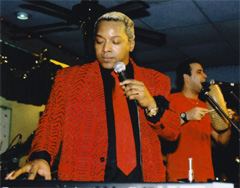
José Luis Cortés y sus Estrellas
José Luis Cortés - Voz, Flauta (Piano/Synth --every now and then--)
Pablo Cortés - Congas
Miguel Angel "Pan con Salsa" de Armas - Piano and Synth
Feliciano Arango - Bajo
Jorge Baglan - Batería
Roberto Arrechea - Trompeta
José Luis Hernández - Sax
Mónica Mesa - Voz, Bongóes, Güiro
Ojeda Helso (last name is not clear) - Voz
María Fernández - Voz
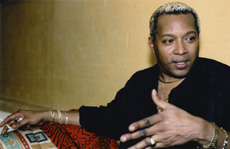
Live in concert, the songs
First Set
1. Intro (Jazz)
2. Baila conmigo
3. Voy pa'l pueblo y cambio a Cha Cha Chá
4. Danzón
5. Son de La Loma
6. ??
Second Set
1. La expresiva
2. Senora Santana ??
3. Necesito una amiga
4. El Trágico
5. Santa Palabra & middle part consisting of Crónica Social with Coro "Quién se llevo la mercancia? La policia!"
Bonus Set
1. Afro Cubano ??
2. Baile Chino
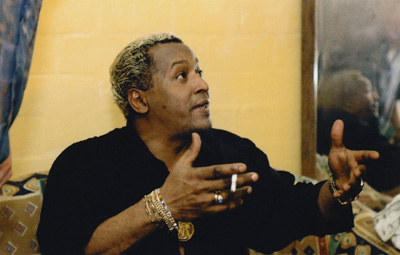
In spite of the absence of the voice of Tony Calá and the brass section (los metales del Terror), this live performance was not to be missed!!
The brass section only consisted of one musician each saxophone and trumpet. Therefore they can not be blamed for the less screaming power we are used to hear from NG La Banda. Especially in the second part of the concert the mambos in La Expresiva, El Trágico and Santa Palabra were a bit thin (politely put as an understatement).
Mónica Mesa was great in "Baila Conmigo", Ojeda Helso (I am not sure about his last name) had a job impossible to accomplish: Stand-in for Tony Calá. He managed well in the first part and he surprised me with his interpretation of Mena's "El Trágico" and Issac's "Necesito una amiga" in the second.
For me it was the first time to see José Luis Cortés perform live. In spite of my remarks mentioned above, the concert, the music, the sound and their performance of all of them together was marvelous, exciting and wonderful. I was off my feet!
I am deeply impressed by what I have heard and seen from Feliciano Arango and Miguel Angel de Armas!
Last but certainly not least: El Tosco. He is great on the flute! I like his voice, although he told me he can not sing ("¡yo no puedo cantar!") and he is a great entertainer (improvising in "La Expresiva" and introducing "Santa Palabra")!
In the first part he told us to relax as timba pa' gozar would be played in the second part. He told us he would start with all Cuban music from Son, Cha cha chá, and Balada to Danzón first.
In the second part everybody was thrown off his feet by fantastic timba, flute solos, Miguelito's synth vamps, great percussion, Feliciano's marvelous bass playing, etc., etc.
He got many, many women –most of them were Cubans– on stage dancing for, to and with him in great despelote.
After this he was wonderful at improvising a few balada verses. He did this for one of the girls from the audience as she eventually bothered him a bit wanting to get on stage dancing with him all the time.
After a short Miguelito, give me a key! he had this short most humorous message for her …
… after all it is just all you imagine yourself … I have had (more than) a hundred women … the worst that I would have was you …
Before he started "Santa Palabra" there was this salute he had to carry on from a Santero back home in Cuba that wished to greet and wish the best for all of us (Cubans) in Berlin (Germany).
As he was introducing "Santa Palabra" teaching us its coro …
… despójate … quítate lo malo … échalo p' atrás … límpiate mi hermano … the band would fantastically come in all of a sudden !
Most exciting was to put in suddenly a part of "Crónica Social" with the provoking coro phrase:
... Quién se llevó la mercancía ...? ...la policía ...!
After all, this is concert I (we) will not ever forget.
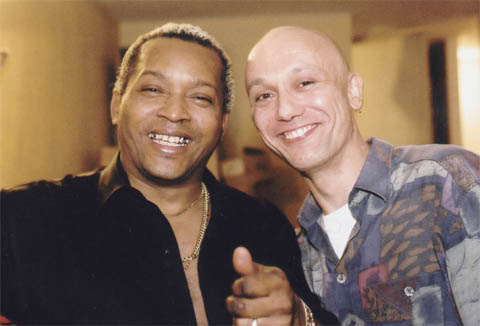
- Maarten Hendrik Liefrink (The Netherlands) for timba.com















